This page gives pointers to various software tools, data repositories, and books which can be used in conjunction with LAMMPS.
We think these kinds of tools, whether freeware or commercial, can be very useful. They extend the scope of problems that LAMMPS can model and its ease of use. We are happy to advertise software and data archives here, so that LAMMPS users can try it out. Send us an email if you want to add something to the list.
GUI and Analysis and Workflow Software - commercial and free software that interfaces with LAMMPS
Molecular Builders - software to build or convert molecular inputs for LAMMPS
Data Sites - website with data usable as LAMMPS input or that archive LAMMPS output
This section describes both commercial and free software that wraps LAMMPS to provide a user-friendly environment for developing models, running simulations, and analyzing the results.
Materials Design, Inc. develops MedeA®, an atomistic simulation and modeling environment that provides productivity, model building and analysis tools for use with LAMMPS. MedeA® simplifies LAMMPS simulations with flowcharts that allow you to assemble complex simulation protocols using simple discrete LAMMPS stages. The resulting LAMMPS simulations are easily shared among colleagues, edited for future reuse, and can be customized by LAMMPS experts.
With MedeA®, atomistic models may be constructed using a variety of methods with the collection of MedeA® builders, which are tools to create input for LAMMPS. They also provide validated methods for the prediction of mechanical properties, including elastic constants, diffusivity, transport properties and cohesive energies based on LAMMPS simulations. MedeA® also facilitates the management of force fields for the simulation of organic, inorganic, and metallic systems; the Materials Design team has an established track record in the development of accurate force fields for organic and metallic systems.
OVITO is a visualization and analysis software for output data generated in molecular dynamics, atomistic Monte-Carlo and other particle-based simulations. It is particularly well interfaced with LAMMPS since some of the OVITO developers are frequent LAMMPS users. The OVITO Pro version also allows to load a LAMMPS shared library and thus create and run LAMMPS simulations directly from OVITO and load the data directly from the simulation without requiring files.
The company Scienomics has developed an interface to LAMMPS as part of their Materials and Processes Simulations (MAPS) platform, which allows both novice LAMMPS users and experts to quickly and efficiently create LAMMPS input files - for both atomistic and DPD simulations. Scienomics provides full phone and email support for LAMMPS users. The LAMMPS Plugin within MAPS also allow users to create input files for LAMMPS, visualize and perform analysis on the output from LAMMPS simulations. MAPS also has a number of force fields to choose from (for atomistic modeling and coarse grain modeling) with LAMMPS. They also have a collection of Builder tools which can be used to create input geometries for LAMMPS plus tools to analyze the results of simulations.
MAPS is a comprehensive software platform incorporating the workflow of Build-Simulate-Analyze. This empowers users with an efficient and seamless way to model complex materials systems, to choose from an array of simulation engines including LAMMPS to model processes, and to analyze output to extract a number of properties such as mechanical, thermal, transport, rheological, etc. See the Scienomics web page for more details on all these tools and services.
Developed by Sergei Shenogin (Rensselaer Nanotechnology Center), shenogin at yahoo.com. This software is free for non-commercial users. XenoView is Windows-based software for molecular dynamics simulation. Its interface provides extensive tools for building the structure from the scratch. Also, you can import structure from many formats (e.g. PDB format). Bonds can be automatically defined and force fields can be automatically assigned. XenoView can export data files and input scripts that can be used in LAMMPS for large-scale simulations. See the XenoView home page for more details.
Atomify is a web-based application that allows you to run LAMMPS simulations purely in the web browser, with real time visualization and plotting of thermodynamic quantities. It comes with several example simulations and allows you to analyze the simulations in a browser based Jupyter notebook solution. Since it requires no installation, it is an excellent choice for new LAMMPS users and in teaching environments.
The atomman tool is open-source (free) software developed by Lucas Hale at NIST. It is a Python package for interacting with large-scale atomic systems. It allows the user to prepare, run, and analyze MD simulations entirely from Python.
LOOS is a package for analyzing molecular dynamics simulations. It is package-agnostic, open source, and runs on all major Linux distributions, as well as OSX. It is distributed with roughly 150 pre-packaged analysis tools, ranging from standard tasks (trajectory manipulation, principal component analysis, etc) to novel tools (assessing simulation convergence, measuring properties of membranes and membrane proteins). Moreover, it is designed for rapid development of new analysis tools, particularly when using the Python wrappers. LOOS is available for download from https://github.com/GrossfieldLab/loos.
LUNAR stands for LAMMPS Utility (for) Network Analysis (and) Reactivity and is a stand alone Python (3.7+) toolkit to supplement LAMMPS. LUNAR is focused on pre-processing and post-processing inputs and outputs of LAMMPS with emphasis of using LAMMPS for producing structure-property relationships for ICME process modeling of polymers. However many of the codes within LUNAR can be used outside of process modeling type of Molecular Dynamics simulations.
LUNAR was written by Josh Kemppainen during his PhD at Michigan Technological Univeristy with Dr. Gregory M. Odegard being his research advisor. LUNAR is maintained by Josh Kemppainen and Dr. Jacob R. Gissinger. LUNAR is not planned on being packaged with PyPi, since all the source code is provided and allows the user to modify the source code easily. If users of LUNAR add considerably substantial modules please notify Josh Kemppainen or Dr. Jacob R. Gissinger to review the additions, such that they maybe included in the LUNAR distribution and maintained for future releases.
When using LUNAR, you agree to acknowledge the use of it in any reports or publications of results obtained with the LUNAR by citing "LUNAR: Automated Input Generation and Analysis for Reactive LAMMPS Simulations" at https://doi.org/10.1021/acs.jcim.4c00730
Freud is a Python library developed and
supported by Sharon Glotzer's group (U Michigan), which provides a
simple, flexible, powerful set of tools for analyzing trajectories
obtained from molecular dynamics or Monte Carlo simulations. High
performance, parallelized C++ is used to compute standard tools such
as radial distribution functions, correlation functions, order
parameters, and clusters, as well as original analysis methods
including potentials of mean force and torque (PMFTs) and local
environment matching. The freud library supports many input formats
MDAnalysis allows one to read particle-based trajectories (including individual coordinate frames such as biomolecules in the PDB format) and access the atomic coordinates through NumPy arrays. This provides a flexible and relatively fast framework for complex analysis tasks. In addition, powerful atom selection commands are implemented. Trajectories can also be manipulated (for instance, fit to a reference structure) and written out.
Inelastic and quasi-elastic neutron scattering (INS and QENS, respectively) spectroscopy are useful tools for probing molecular dynamics in materials. Atomistic simulations, particularly molecular dynamics (MD) simulations are being used increasingly for analysis of these data. However, predicting neutron observables from MD trajectories is not straightforward. A number of operations, such as calculations of velocity auto- and cross-correlation functions, Fourier transformations and convolutions with instrument parameters are required to calculate neutron observables that can be compared directly with experimental data.
Some of these steps are implemented in the open source MDANSE (Molecular Dynamics Analysis of Neutron Scattering Experiments). This software has interface with more than ten MD codes including some ab-initio MD codes, such as CASTEP, VASP, DMOL, Gromacs, DL_POY, CHARMM, LAMMPS, PBD, DFTB etc. showing potential to be used widely.
The package is currently being revised and modernized and it can be obtained from https://github.com/ISISNeutronMuon/MDANSE or https://pypi.org/project/MDANSE-GUI/
The mdapy Python library offers a wide range of powerful, flexible, and user-friendly tools for analyzing atomic trajectories obtained from Molecular Dynamics (MD) simulations. This library is fully cross-platform, making it accessible to users on Windows, Linux, and Mac OS. Leveraging the TaiChi project has enabled the effective acceleration of pure Python code, bringing its performance closer to that of C++ code. Additionally, mdapy is optimized for parallel processing, allowing users to harness the computing resources of both multicore CPUs and GPUs. mdapy is capable of directly handling data in formats such as DUMP and DATA from LAMMPS, POSCAR from VASP, universal XYZ format, and CIF format. Moreover, all data within mdapy is stored in the NDARRAY format of NumPy, facilitating seamless integration with the scientific Python ecosystem and enabling collaboration with other post-processing tools.
For more information, please visit:
MolTwister is an open source software package. It can aid in the construction of molecular systems used as input to molecular dynamics simulations. However, its primary purpose is to provide a collection of analysis tools for post-processing of trajectories and data from molecular dynamics simulations. This includes calculation of density profiles, velocity auto correlation functions, radial distribution functions, dihedral distributions and more.
The software runs in a command line window and will act as an extension to the ordinary command line window, running in the background. Hence, an additional set of commands are available for creating and analyzing molecular systems from the command line. Commands not recognized by MolTwister is sent for processing as a regular command (e.g., vim can be executed directly from within MolTwister). In addition to the extended command line, a 3D View window will display the molecular system being edited or created.
PyLAT is a Python software developed in the group of Ed Maginn at Notre Dame for post-processing output from LAMMPS simulations. Details about it can be found in this publication .
TRAVIS ("TRajectory Analyzer and VISualizer") is a free program package for analyzing and visualizing Monte Carlo and molecular dynamics trajectories. The aim of TRAVIS is to collect as many analyses as possible in one program, creating a powerful tool and making it unnecessary to use many different programs for evaluating simulations. TRAVIS is written in C++, open-source freeware and licensed under the terms of the GNU General Public License (GPLv3). It is easy to install (platform independent, no external libraries) and easy to use.
To simulate molecular systems LAMMPS requires you to input molecular topologies (lists of bonds, angles, dihedrals, etc) as well as force-field coefficients appropriate for your model. Thus the task of building a molecular system is a pre-processing step, and can be a complex task of its own.
This section describes tools that help to automate this process.
Generally speaking, the packages can infer angle, dihedral, and improper interactions from bond topology. They have commands to generate molecular geometry. They can read coordinates from files generated by PACKMOL and other PDB file builders.
Developed and maintained by Pieter J. in 't Veld (BASF), veld at verizon.net.
Enhanced Monte Carlo, or EMC for short, provides an environment for creating and manipulating input structures for particle simulations using COMPASS, CHARMM, OPLS, Martini, DPD, or colloidal force fields. To this end, a scripting language manages access to its functionality. The current version provides manipulation of molecular or coarse-grained structures through SMILES strings, typing these structures - when needed - for selected force fields, and building conformations applying Monte Carlo principles to unoverlap atoms. EMC provides output ports to LAMMPS, PDB, and XYZ formats. A compiled version for Linux, MacOS, or Windows can be found at montecarlo.sourceforge.net
EMC has a user forum on MatSci.org at https://matsci.org/c/emc/50
Here are examples of systems built with EMC. Click on them for a larger image.


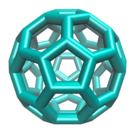


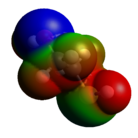
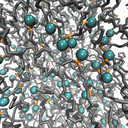
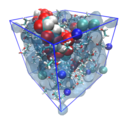
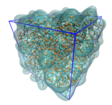



Developed and maintained by Andrew Jewett (UCSB), jewett.aij at gmail.com.
This tool is distributed with LAMMPS in the tools/moltemplate directory. See that directory and the moltemplate home page for more details.
Moltemplate was designed for building coarse-grained biomolecular models. Moltemplate can create both: lammps DATA files (containing geometry and topology), and lammps INPUT scripts (containing force-fields, fixes, and groups). Unlike files generated by other conversion tools, moltemplate gives users access to all of the force-fields available in LAMMPS. Users can save molecules in moltemplate's compact, readable template file format (".LT"), and share them with others. Molecules can be used as building blocks for bigger molecules. "Canned" force-fields (such as Dreiding, GAFF, TraPPE, and user creations) can (in principle) also be saved in this format and applied to molecules later.
Molecules can be copied, combined, and linked together to define new molecules. (These can be used to define larger molecules. Unlimited levels of object composition, nesting, and inheritance are supported.) Once built, individual molecules and subunits can be customized (atoms and bonds, and subunits can be moved, deleted and replaced).
Here are examples of systems built with moltemplate. Click on them for a larger image.
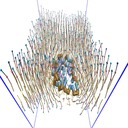
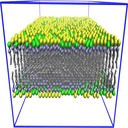
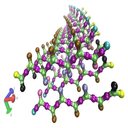
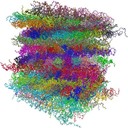
Developed and maintained by Axel Kohlmeyer (Temple U), akohlmey at gmail.com.
See the TopoTools home page for more details.
Topotools is a molecule builder which leverages the power of VMD and TCL to create lammps DATA files and convert them to and from other formats. Topotools has two components: a middleware script which can extract and manipulate topology information, and several high-level applications built on top of it, which, for example can enable it to read/write data files, replicate and merge systems. Together with VMD, topotools can infer topology from PDB files, PSF files, and atom pair distances, solvate a protein. Additional features for coarse-grained molecules are planned.
Here are examples of systems built with TopoTools. Click on them for a larger image.
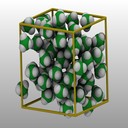
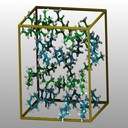

IntelMol is written in Python and can do Desmond<=>Gromacs<=>Lammps conversions natively in InterMol; AMBER->X is carried out by converting AMBER to GROMACS, then to other programs using ParmEd. AMBER->CHARMM is carried out by ParmEd directly.
Developed and maintained as an open-source project.
See the Avogadro home page for more details.
Avogadro is an advanced molecule editor and visualizer designed for cross-platform use in computational chemistry, molecular modeling, bioinformatics, materials science, and related areas. It offers flexible high quality rendering and a powerful plugin architecture.
Developed and maintained as an open-source project.
See the Packmol home page for more details.
Packmol creates an initial point for molecular dynamics simulations by packing molecules in defined regions of space. The packing guarantees that short range repulsive interactions do not disrupt the simulations.
Developed and maintained as an open-source project.
See the Atomsk home page for more details.
Atomsk aims at creating, manipulating, and converting atomic systems. It supports many file formats, among which LAMMPS files formats, and also VASP, Quantum Espresso, IMD, DL_POLY, Atomeye CFG format, or xCrySDen XSF format, which makes it easy to convert files for ab initio calculations, classical potential simulations, or visualization. Additionnaly, atomsk can also perform some simple transformations of atomic positions, like rotation, deformation, inserting dislocations.
polyGraft is developed and maintained by Guang Chen to help build the initial structure and topology file of polymer-grafted hybrid systems. A broad range of polymer-grafted hard or soft nanostructures can be generated using polyGraft, such as polymer-grafted nanoparticles, nanoslabs (planar brush), and nanorods/nanopores and bottlebrush polymers, considering the chain length and grafting density of the polymer graft, and size and shape of the substrate. Here are some examples of systems built with polyGraft.
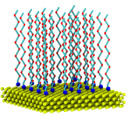
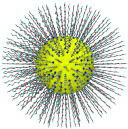
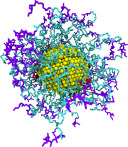
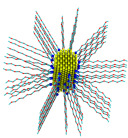
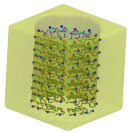




OCTA is an open source software package which consists of simulation engines (Molecular Dynamics, Rheology simulation, Self Consistent Field Theory, Finite Element Method, etc) and a GUI (visualization, simple molecular builder and analysis tools) for modeling soft matter systems.
OCTA also provides an environment for the collaborative usage of several kinds of simulators, i.e. multi-physics and multi-scale simulations.
By using the commercial version J-OCTA, complex molecular building for full atomistic and coarse grained MD can also be performed.
This Python program was designed as an easy to use interface between crystallographic information files (.cif) and LAMMPS. By default it will create LAMMPS input files using the UFF force field from CIF files. The CIF file are expected to be in P1 symmetry.
MoSDeF presents a set of extensible Python tools designed to facilitate the initialization, atom-typing, and screening of soft matter systems using molecular simulation.
The ATB project is led by Prof Alan E. Mark (University of Queensland, Australia); the ATB website has a list of the other contributors to the effort.
The ATB provides topology files for organic molecules in formats compatible with LAMMPS and other molecular dynamics packages. The LAMMPS topology files enable the construction of complex systems using the moltemplate tool (distributed with LAMMPS). Moltemplate allows forcefield parameters and molecule template files to be combined to build complex systems, enabling a workflow similar to that used to build system topologies in biomolecular MD simulation packages (e.g. GROMOS, AMBER, CHARMM, etc).
The ATB site provides topologies for a wide variety of molecules (> 20,000 and growing). Molecules can be found using the internal search tools based on name or chemical formula and selecting from the list of results. Once on the page for the molecule of interest, you can select "Molecular Dynamics (MD) Files" and choose "LAMMPS" as the output "Format" If a molecule does not exist in the database, it can be added by submitting a new molecule to be processed (instructions in the site FAQ).
cif2cell Converter of CIF Files for Simulation Software Packages
CIF2Cell is a tool to generate the geometrical setup for various electronic structure codes from a CIF (Crystallographic Information Framework) file. The program currently supports output for a number of popular simulation and electronic structure programs, including LAMMPS, ABINIT, ASE, CASTEP, CP2K, CPMD, CRYSTAL09, Elk, EMTO, Exciting, Fleur, FHI-aims, Hutsepot, MOPAC, Quantum Espresso, RSPt, Siesta, SPR-KKR, VASP. Also exports for some common geometry file formats like .coo, .cfg and .xyz-files are available . The program has been published in Computer Physics Communications 182 (2011) 1183–1186.
CIF2Cell is a python software and module and can be conveniently installed via pip from PyPi and via conda from conda-forge
Geoparticle - a Python programme for particle-based geometry construction
Particles of specified geometries are typically created by the lattice command in LAMMPS, which can lead to rough surfaces when the particle spacing is not small enough. However, too small spacing can result in too many particles and thus increase the computational cost. A similar issue can happen when one creates atoms based on an external STL file. The aim of the geoparticle software is to easily construct geometries where smooth surfaces are required.
The geoparticle repository is hosted on GitHub and you can find its documentation on Read the Docs It can be conveniently installed via pip from PyPi with:
pip install geoparticle
This section lists WWW sites that provide data that can be used with LAMMPS. For example, atomic configurations, that can be used to initialize models for LAMMPS simulations. Or an archive of calculations done with LAMMPS that can be browsed for physical or model insight.
JARVIS for force-fields (JARVIS-FF) is a high-throughput computational database for LAMMPS calculations on Density functional theory (DFT)-optimized geometric structures with various force-fields/interatomic potentials. The goal of the project is to provide an easy look-up table for evaluation of force-fields through a web-interface and to enhance data-reproducibility. JARVIS-FF is a part of the Materials Genome Initiative (MGI) at the National Institute of Standards and Technology (NIST).
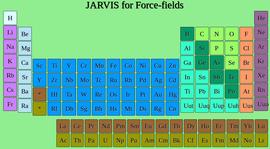 Click for larger image.
Click for larger image.
See https://jarvis.nist.gov/ for details.
The Crystallography Open Database (COD) is an open-access collection of crystal structures of organic, inorganic, metal-organic compounds and minerals, excluding biopolymers. It contains over half a million of crystal structures in CIF format.